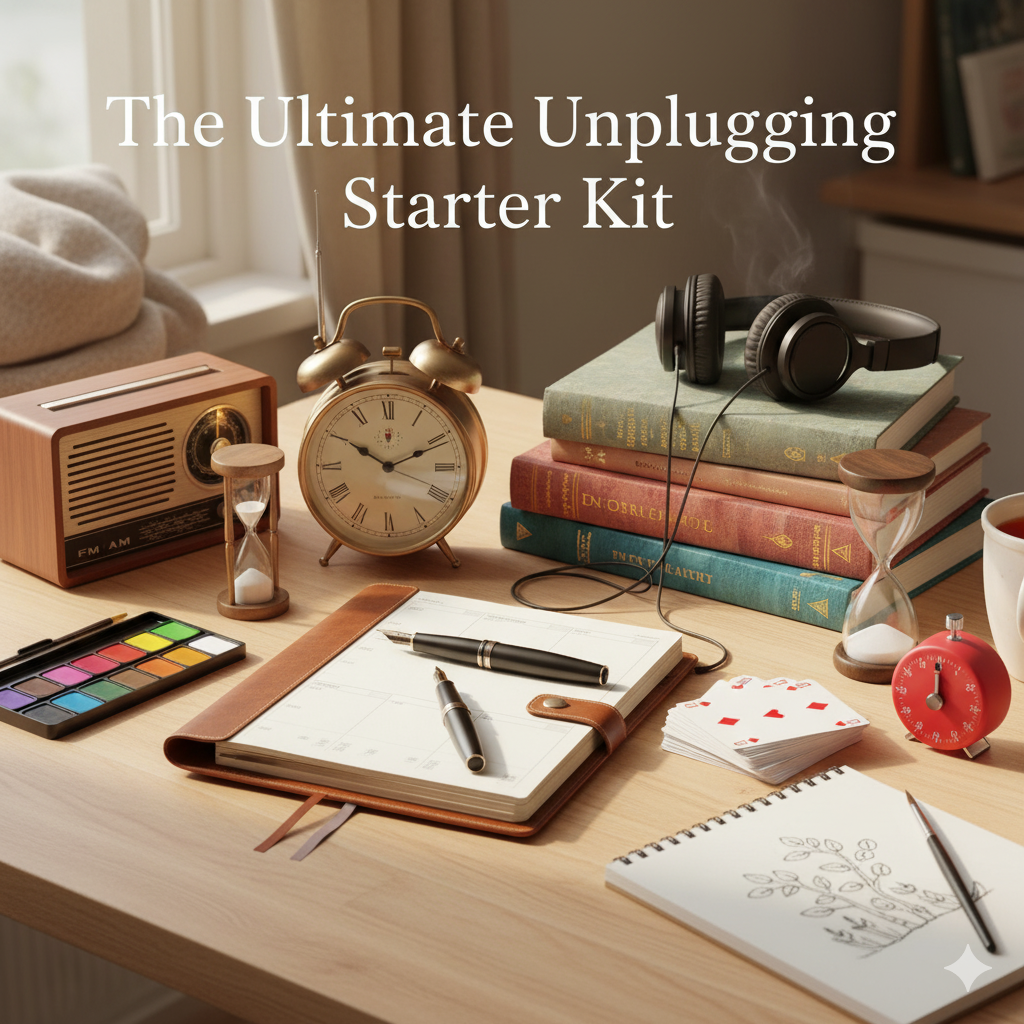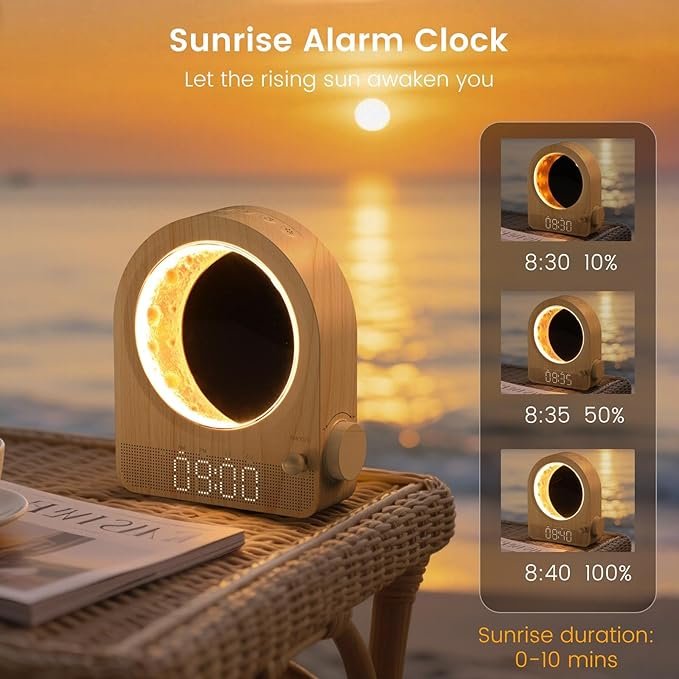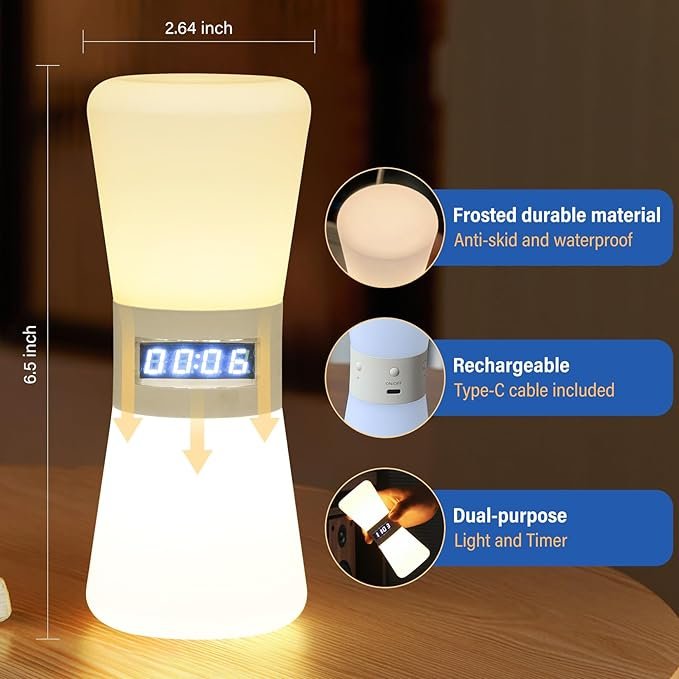Tired of the endless scroll? Feeling constantly tethered to your devices? You’re not alone. In our hyper-connected world, the idea of a “digital detox” has moved from a trendy buzzword to a vital necessity for our mental well-being. But where do you even begin? How do you create an environment that encourages genuine disconnection without feeling deprived or overwhelmed?
Welcome to your guide to The Ultimate Unplugging Starter Kit! This isn’t about throwing out your smartphone forever (unless you want to!). It’s about equipping yourself with simple, effective, low-tech tools for unplugging that empower you to intentionally step away from screens, reclaim your attention, and rediscover the calm clarity that digital overload often steals.
Think of it as building a sanctuary – one intentional, low-tech item at a time. Ready to transform your relationship with technology and embrace a more present life? Let’s dive into your essential toolkit!

Why an Unplugging Starter Kit Matters More Than Ever
Before we explore the tools, let’s acknowledge the elephant in the digital room. Our devices are incredible, offering instant access to information, connection, and entertainment. Yet, this constant accessibility comes at a cost:
- Fragmented Attention: Our brains are constantly context-switching, making deep focus a rare commodity.
- Information Overload: The sheer volume of data can lead to decision fatigue and anxiety.
- Erosion of Presence: We often miss out on the beauty of the real world because our eyes are glued to a screen.
- Sleep Disruption: Blue light from screens interferes with melatonin production, leading to restless nights.
An unplugging starter kit acts as your personal defense system against these digital downsides. It provides tangible alternatives, nudging you towards activities that nourish your mind, body, and spirit without the constant pull of the digital world. It’s about creating an unplugged routine that feels less like a restriction and more like a liberating choice.
Your Essential Unplugging Starter Kit: Build Your Sanctuary
Let’s explore the foundational items that will form the backbone of your peaceful digital detox.
1. A High-Quality Paper Planner or Notebook
In an age of endless digital calendars and task apps, the simple act of writing by hand remains incredibly powerful. A dedicated paper planner or notebook is the cornerstone of your unplugging journey and one of the best low-tech tools for unplugging.
- The Power of Pen to Paper: Studies show that writing things down by hand engages more parts of your brain, leading to better memory retention and a stronger commitment to your tasks and goals. It’s a tactile way to ground your intentions.
- Distraction-Free Planning: Unlike your phone, a physical planner won’t tempt you with notifications, social media feeds, or email alerts. It’s a dedicated space for your thoughts, schedules, and reflections, allowing for uninterrupted focus.
- Visual Clarity: Spreading out your week or month on a physical page gives you an immediate, comprehensive overview. You can see your commitments, priorities, and free time at a glance, making it easier to manage your schedule intentionally.
- Mindful Reflection: Use your planner not just for appointments, but for daily journaling, tracking habits, sketching ideas, or noting down moments of gratitude. It transforms from a mere schedule into a personal record of your journey towards a more intentional life.
Why it’s Essential for Unplugging: By moving your scheduling, to-do lists, and brainstorming off your devices, you significantly reduce your screen time and cultivate a more mindful approach to managing your day. It’s a physical anchor in a digital storm.
Pro-Tip: Don’t just pick any planner. Choose one that you genuinely love to use—consider the paper quality, the binding, and a layout that suits your planning style (daily, weekly, bullet journal, etc.). Pair it with a smooth-writing pen that makes the experience a joy.

2. An Analog Alarm Clock (No Smart Features!)
This might seem like a small detail, but removing your smartphone from your bedroom is one of the most impactful steps you can take for a successful digital detox. An analog alarm clock is the indispensable tool for achieving this.
- The Bedroom Boundary: Your phone is a portal to the entire digital world. When it’s by your bed, the temptation to check it “just one more time” before sleep, or immediately upon waking, is immense. An analog clock serves one purpose: to wake you up.
- Improved Sleep Hygiene: The blue light emitted by phone screens disrupts your body’s natural production of melatonin, a hormone crucial for sleep. Keeping your phone out of the bedroom allows your brain to wind down properly, leading to deeper, more restorative sleep.
- Mindful Mornings: Waking up to a gentle alarm, rather than a buzzing phone filled with notifications, sets a calmer tone for your entire day. It gives you the space to engage in a morning routine of your choosing—meditation, reading, or simply enjoying a quiet moment—before the digital demands begin.
- Reduced Nighttime Scrolling: How many times have you picked up your phone in the middle of the night to check the time, only to fall into a social media rabbit hole? An analog clock prevents this common sleep disruptor.
Why it’s Essential for Unplugging: This simple item breaks the cycle of screen-dependent sleep and waking, creating a vital boundary between your rest and the digital world. It’s a declaration that your bedroom is a sanctuary, not an extension of your office or social feed.
Pro-Tip: Place your alarm clock a few feet away from your bed. This forces you to physically get up to turn it off, making it less likely you’ll hit snooze and more likely you’ll start your day with intention.
3. A Quality Physical Book (or several!)
In an era of endless streaming and bite-sized content, the physical book remains the ultimate low-tech tool for deep immersion and sustained focus.
- Deep Reading, Deep Focus: Reading a physical book demands your full, uninterrupted attention. There are no hyperlinks, no notifications, and no other apps competing for your gaze. This practice strengthens your concentration muscles, which are often atrophied by constant digital stimulation.
- Sensory Experience: The feel of the paper, the smell of the ink, the turning of pages—these tactile elements enhance the reading experience and ground you in the present moment, making it more satisfying than reading on a screen.
- Screen-Free Escape: A physical book offers a perfect escape from reality without the blue light or mental overstimulation of digital devices. It’s a wonderful way to wind down before bed, transport yourself to another world, or simply relax in a quiet corner.
- Curiosity & Discovery: Choosing a book, whether from a library or bookstore, involves an intentional act of discovery that feels different from scrolling through endless digital recommendations. You commit to a story or topic in a more deliberate way.
Why it’s Essential for Unplugging: Books are powerful antidotes to digital fatigue. They encourage sustained attention, stimulate imagination, and provide a peaceful, screen-free alternative for entertainment and learning.
Pro-Tip: Keep a “Currently Reading” stack by your bed or in your living room. Having physical books readily accessible makes it easier to pick one up instead of automatically reaching for your phone. Don’t be afraid to reread old favorites!
4. A Simple FM/AM Radio (or a dedicated music player)
Music is a powerful tool for mood, focus, and relaxation. While streaming services offer convenience, a simple radio or a dedicated, non-internet-connected music player brings a delightful sense of serendipity and focus to your auditory experience.
- Background Ambiance, Not Distraction: A radio provides pleasant background sound—music, news, or talk—without the visual temptation of a screen. It fills a silent space without demanding your full attention, allowing you to focus on other tasks.
- Serendipitous Discovery: Unlike algorithm-driven playlists, tuning into a radio station offers a chance to discover new music, local artists, or different perspectives you might not have actively sought out. Embrace the unexpected!
- Local Connection: FM/AM radio often connects you to your local community—local news, weather, traffic updates, and community events. It fosters a sense of place and belonging that can be lost in global digital feeds.
- Mindful Listening: A dedicated music player, like a record player or even an old MP3 player without Wi-Fi, transforms music from background noise into an intentional listening experience. You choose an album or playlist and simply listen, without interruption.
Why it’s Essential for Unplugging: It provides a screen-free source of audio entertainment and information, allowing you to enjoy music or stay informed without the constant pull of a multi-purpose digital device.
Pro-Tip: Find a charming retro-style radio that fits your decor, or bring out that old boombox from the attic! Create a small “listening station” in your home where you can simply enjoy music without digital interference.
Expanding Your Unplugging Arsenal: Beyond the Basics
While the first four items are your absolute must-haves, these next three additions can significantly enhance your digital detox efforts and make your unplugged routine even more robust. These are fantastic secondary low-tech tools for unplugging.
5. Art Supplies (Sketchbook, Pencils, Paints)
Creative expression is a powerful way to engage your mind and hands, pulling you away from screens and into a state of flow. You don’t need to be an artist; just the act of creating is beneficial.
- Mindful Engagement: Drawing, painting, or even just doodling can be incredibly meditative. It requires focus and presence, allowing your mind to quiet the digital chatter. It’s a key form of “Mindfulness through Making.”
- Sensory Richness: The feel of a pencil on paper, the smell of paint, the vibrant colors—these sensory experiences are a welcome contrast to the flat, glowing screen.
- Self-Expression: Creating something with your hands offers a unique sense of accomplishment and self-expression that passive consumption of digital content cannot provide.
- Screen-Free Hobby: Having readily available art supplies gives you an immediate, engaging alternative to reaching for your phone when boredom strikes.
Why it’s Essential for Unplugging: It provides a constructive, engaging, and screen-free outlet for creativity and self-expression, fostering focus and a sense of calm.
Pro-Tip: Start small! Get a simple sketchbook and a set of colored pencils or watercolors. Dedicate 15 minutes a day to drawing something you see in the room—a great exercise in focused observation!
6. A Deck of Cards or a Simple Board Game
Connecting with others face-to-face is a vital part of a balanced life, and traditional games are perfect for fostering genuine interaction without screens.
- Real-World Connection: Unlike online gaming, a physical card game or board game requires direct interaction, conversation, and shared laughter with other people in the same room. It strengthens bonds and social skills.
- Shared Focus: Everyone involved is looking at the same physical game, engaging with each other, rather than being in their own digital worlds on separate devices.
- Cognitive Engagement: Many card and board games require strategy, memory, and problem-solving, providing a fun and stimulating mental workout that is entirely screen-free.
- Breaks the Habit: Having a go-to game ready makes it easier to suggest “Let’s play cards!” instead of defaulting to “Let’s all look at our phones.”
Why it’s Essential for Unplugging: It encourages face-to-face social interaction, provides engaging entertainment without screens, and helps build real-world connections.
Pro-Tip: Keep a small, non-electronic game or a deck of cards near the dining table. Make a rule that the first person to finish eating gets to set up the game for post-meal fun.

7. A Physical Timer (Hourglass or Kitchen Timer)
For focused work sessions or designated unplugged periods, a simple physical timer is a powerful, low-tech tool for time management.
- The Pomodoro Technique Made Simple: Use the timer to set 25-minute periods of hyper-focused work, followed by a 5-minute break. The visual countdown and the gentle “ding” at the end are less intrusive than digital alerts.
- Screen-Free Boundaries: Use a timer to set limits for screen time if you’re allowing some, or to define periods when you are completely unplugged. When the timer is on, no screens allowed.
- Mindful Awareness: An hourglass, in particular, offers a visual, calming way to mark the passage of time without the harshness of a digital clock. It encourages a more mindful approach to how you spend your moments.
- Breaks & Transitions: A timer helps you take intentional breaks, signaling when it’s time to step away from a task and move onto something else, preventing endless scrolling during your “break time.”
Why it’s Essential for Unplugging: It helps manage time and create focused blocks without relying on a digital device, promoting better concentration and intentional transitions.
Pro-Tip: Get an attractive hourglass for your desk as a visual reminder of focused time, or a classic kitchen timer for active work sessions.
Building Your Unplugged Routine: Beyond the Tools
Having The Ultimate Unplugging Starter Kit is just the beginning. The real magic happens when you integrate these tools into an unplugged routine.
- Start Small, Stay Consistent: Don’t try to go completely device-free overnight. Begin with one low-tech swap—like using your analog alarm clock instead of your phone for a week. Consistency builds habit.
- Designated Unplugged Zones: Create areas in your home (e.g., the bedroom, the dining table) where screens are strictly off-limits. Use a phone basket by the door to make putting your phone away a mindful ritual.
- Scheduled Unplugged Time: Block out specific times in your day or week for a digital detox. It could be an hour before bed, during meals, or a “Screen-Free Saturday.” Put it in your new physical planner!
- Embrace Boredom: When you first unplug, you might feel a pang of boredom. This is a good thing! It’s your brain’s way of seeking stimulation. Instead of reaching for your phone, pick up a book, grab your art supplies, or simply sit with your thoughts. This is where creativity flourishes.
Conclusion: Your Path to a More Present Life
You don’t need to move off-grid to find peace and focus. The Ultimate Unplugging Starter Kit provides a practical, achievable path to a more intentional relationship with technology. By choosing these essential low-tech tools for unplugging, you’re making a conscious decision to prioritize your well-being, deepen your connections, and rediscover the simple joys of a life lived fully in the present moment.
Remember, this isn’t about deprivation; it’s about liberation. It’s about empowering yourself to choose when and how technology serves you, rather than letting it dictate your every moment.
Ready to start building your sanctuary?
Action Step: Look around your home. Which one item from The Ultimate Unplugging Starter Kit can you acquire or dust off today? Get that analog alarm clock, pick up a new book, or invest in a beautiful planner. Then, commit to using it as part of your new unplugged routine this week.
Share your journey! What’s the first low-tech tool you’re adding to your unplugging starter kit? Tell us in the comments below and inspire others to embrace a more present and peaceful life!